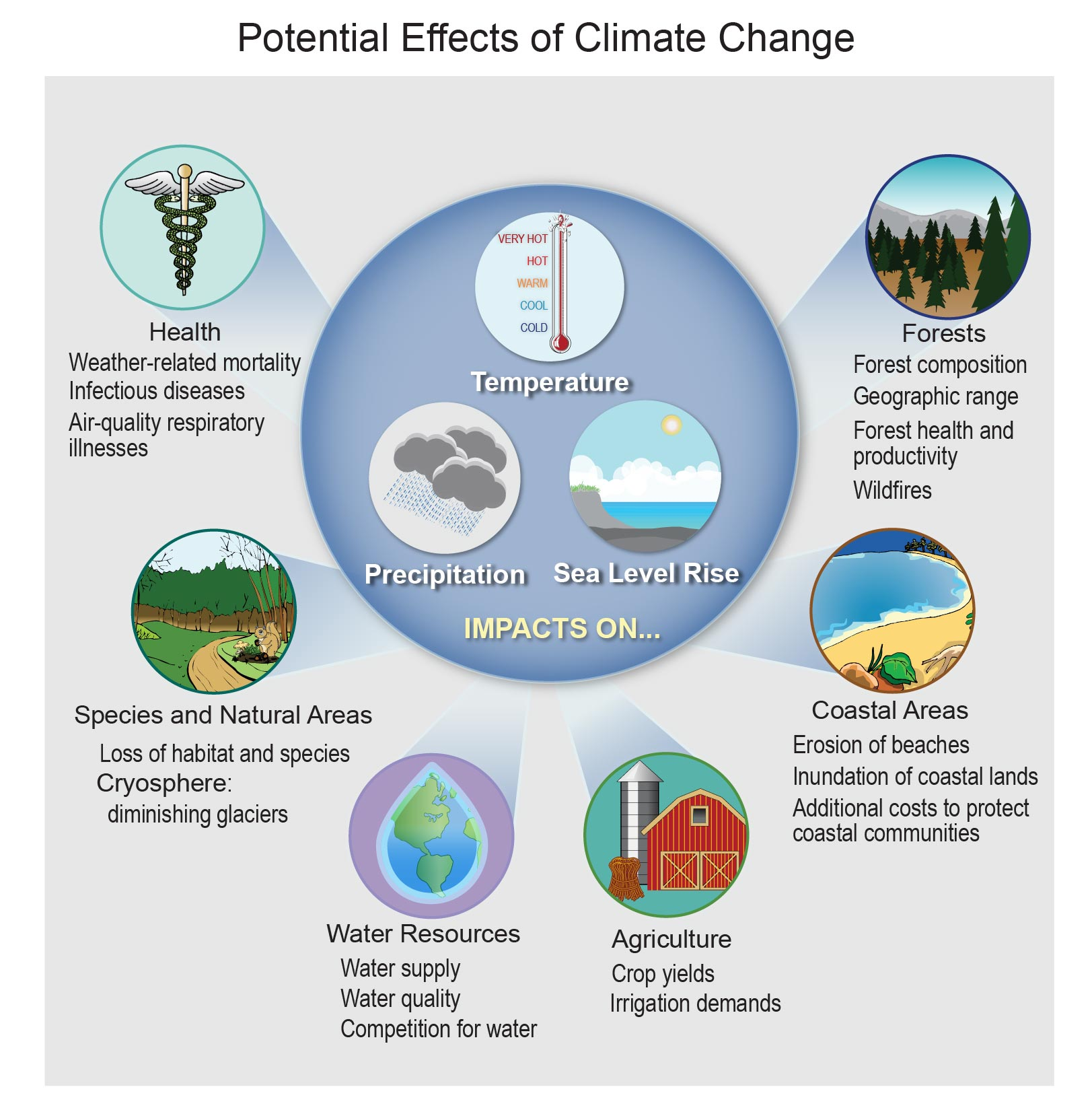Climate change impacts are reshaping our environment at an alarming rate, heavily influencing ecosystems across the globe. Research conducted at Harvard Forest highlights the significant shifts occurring within forest ecosystems due to warming temperatures effects. As species like hemlock decline, there’s been a remarkable increase in black birch growth, fundamentally altering the landscape’s character. The insights gained from this long-term research illustrate that these ecological changes are not merely theoretical; they are vivid, personal experiences shared by the dedicated scientists witnessing them firsthand. By exploring the interplay of climate dynamics and biodiversity, we can better understand the urgent need to tackle climate change and its repercussions.
The repercussions of climate change, often termed global warming effects, are becoming increasingly evident throughout various habitats. Ongoing studies in regions such as Harvard Forest reveal dramatic forest ecosystem changes as species adapt or vanish in response to rising temperatures. The decline of iconic trees like hemlock can create new opportunities for other species, fostering growth of black birch and transforming the forest’s appearance and function. Understanding these shifts is crucial for developing effective conservation strategies and appreciating the resilience of nature amid challenging environmental conditions. Engaging with these alternative ecological narratives allows us to paint a clearer picture of the climate crisis and bolster our collective efforts to mitigate its impact.
The Role of Harvard Forest in Climate Change Research
Harvard Forest serves as a critical research hub for understanding the complex dynamics of climate change. Established over a century ago, it has become a vital resource for scientists from around the globe, thanks to its extensive historical data on temperature and precipitation. This repository of information extends back to the 1960s and is complemented by even older records from the nearby town of Amherst. Such data is essential for identifying long-term climate trends amidst the noise of annual variability. The ongoing research at Harvard Forest focuses not only on the current impacts of climate change but also on predicting future shifts within forest ecosystems.
The insights gained from Harvard Forest’s research projects are crucial for establishing baseline data on how warming temperatures are currently altering the region’s ecology. With about 100 research initiatives taking place at any given moment, scientists are examining conditions related to invasive species, soil chemistry changes, and the effects of increased rainfall intensity. These studies demonstrate how interconnected the components of forest ecosystems are, revealing the nuanced ways in which climate change affects both flora and fauna.
Impacts of Climate Change on Forest Ecosystems
The impacts of climate change on forest ecosystems are profound and multifaceted. As temperatures rise, significant shifts have been observed in species viability and distribution within Harvard Forest. For example, the decline of hemlocks, once a dominant species in the area, has been linked to the activity of the woolly adelgid, an invasive insect that thrives in warmer conditions. The decline of this species not only alters the landscape but also affects overall ecosystem health, as hemlocks play a vital role in regulating temperature and maintaining soil acidity. The transformation of hemlock forests to black birch-dominated environments illustrates the direct correlation between climate change and biodiversity loss.
Moreover, warming temperatures have resulted in altered precipitation patterns, leading to extremes such as heavy summer rainfall, which can exacerbate soil erosion and affect groundwater levels. The subsequent shift in species composition—where black birches thrive in the absence of hemlocks—highlights the adaptive resilience of forest ecosystems. However, this transition may come at a cost, including changes in nutrient cycling and habitat quality for wildlife. The research at Harvard Forest emphasizes the urgency of understanding these changes as they unfold, indicating that the ongoing climate crisis requires immediate attention and action to mitigate its effects on natural landscapes.
The Resilience and Adaptability of Forest Ecosystems
Despite the significant challenges posed by climate change, forest ecosystems display a remarkable capacity for resilience. The Harvard Forest researchers have observed that even as hemlocks decline due to infestations by invasive species, the emergence of other species such as black birch demonstrates the ability of forests to adapt to changing conditions. These shifts in species composition can promote biodiversity and maintain ecological functions. The resilience of these ecosystems serves as a hopeful reminder that nature can often withstand significant disturbances, provided interventions such as conservation and responsible management are applied effectively.
However, the rapid pace of climate change raises concerns about whether this adaptability will be sufficient in the long run. The concept of shifting baselines, as mentioned by Harvard Forest Director Missy Holbrook, highlights the generational differences in environmental experience, leaving future generations with a landscape that may fundamentally differ from the past. This underscores the necessity of ongoing research and education to inform conservation efforts and maintain a connection between people and their changing environment.
Hemlock Decline and Its Ecosystem Consequences
The decline of hemlocks in Harvard Forest due to climate change and invasive species presents serious ecological consequences. Hemlocks are essential to the forest’s structure and function, acting as keystone species that support diverse plant and animal life. Their dense canopies provide critical shade and habitat for cold-water fish, while their acidic needles influence soil chemistry, making it less welcoming for competing plant species. As these trees die off, they pave the way for alternative species like black birch to proliferate, leading to a significant alteration in the forest’s microenvironment and biological community.
Researchers like David Orwig are observing these changes closely, monitoring the shift from hemlocks to more sun-tolerant deciduous species. While black birches flourish, the ecological balance of the forest is inevitably altered. The warming climate presents a paradox: while it enables some species to thrive, it simultaneously endangers others, threatening the overall health and diversity of the forest. Understanding these dynamics is crucial for effective forest management and conservation strategies as the climate continues to shift.
The Interaction Between Climate Change and Invasive Species
Invasive species pose one of the most pressing challenges to forest ecosystems already stressed by climate change. At Harvard Forest, the woolly adelgid exemplifies how invasive pests can exploit warming temperatures to encroach on native habitats. These pests are not only detrimental to hemlocks but also alter the broader ecological interactions within the forest, as their decline leads to changes in flora and fauna. This dynamic illustrates the complex interplay between climate change and invasive species, making it imperative to develop integrative management strategies that address both threats concurrently.
The rise of black birch is a direct response to the decline in hemlocks, which highlights the importance of studying invasive species alongside climate impacts. Effects on soil chemistry and biodiversity can have cascading consequences on ecosystem health, demonstrating how one change can lead to a domino effect throughout the environment. Strategies that combine habitat restoration, invasive species control, and climate resilience planning are vital to safeguarding forest health and biodiversity.
The Importance of Long-term Ecological Data
Long-term ecological data is fundamental to understanding the impacts of climate change on forest ecosystems. Researchers at Harvard Forest benefit from decades of meticulous record-keeping, enabling them to detect patterns and trends that short-term studies might overlook. This invaluable data spans over 100 years and allows scientists to discern significant shifts in temperature, precipitation, and species distribution—information crucial for anticipating future changes. Detailed observational records reveal subtle changes in ecosystem dynamics over time and underscore the importance of historical context in current conservation efforts.
With long-term environmental data, researchers can model potential future scenarios that inform policy and management decisions. The ability to compare historical data with present observations helps scientists understand the rate of change and gauge the effectiveness of conservation strategies in mitigating the effects of climate change. Programs that focus on the integration of historical ecological data and ongoing research are essential to build resilient forest ecosystems that can withstand the pressures of climate change.
Community Engagement in Climate Change Awareness
Engaging local communities is crucial in the fight against climate change, and Harvard Forest exemplifies how educational outreach can foster awareness and action. Clarisse Hart and her colleagues encourage an experiential learning approach, aiming to emotionally connect individuals to their natural surroundings. By educating visitors about the impacts of climate change on the forest ecosystem, particularly through firsthand experiences, they help build a collective sense of stewardship. When community members understand the health of their local forests, they are more likely to support conservation initiatives and sustainable practices.
Building a sense of community regarding environmental changes also helps address the challenges posed by shifting baselines. As people adapt their understanding of what nature should look like based on personal experience, programs that connect current generations with the ecological heritage of the region are essential. Creating opportunities for people to engage with the forest through volunteer efforts, workshops, and citizen science projects ensures that the importance of preserving local ecology is recognized and appreciated by all.
The Future of Forest Ecosystems in a Warming Climate
As climate change continues to reshape forest ecosystems, understanding potential future scenarios becomes crucial. Research at Harvard Forest indicates that increased temperatures and altered precipitation patterns will likely bring more variability to forest dynamics, leading to shifts in species composition and health. For instance, while black birch may currently thrive in the absence of hemlocks, the long-term sustainability of such a shift is uncertain. Ecosystems are complex, and the ramifications of ongoing changes may lead to unforeseen consequences on biodiversity and carbon storage capabilities.
To prepare for these future changes, scientists are focusing on adaptive management strategies that incorporate ongoing research findings. This foresight involves protecting and nurturing native species while also exploring innovative conservation approaches that can be used in changing climates. Communities, policymakers, and scientists must collaborate to anticipate challenges and opportunities presented by climate change to ensure forest ecosystems can adapt and continue to thrive.
Personal Reflections on Climate Change at Harvard Forest
The personal narratives of researchers at Harvard Forest underscore the deep emotional connections individuals have with their natural surroundings. David Orwig’s reflections on the decline of hemlocks reveal a profound sense of loss felt by those who have spent decades studying and appreciating these majestic trees. Such emotional ties illustrate the significance of long-term ecological monitoring—not just in scientific terms but on a human level as well. Researchers like Orwig and Holbrook emphasize the need to share these personal stories to foster a greater understanding of climate change effects on ecosystems.
These reflections also highlight the intergenerational impact of climate change. As future generations grow up in a world where they may not experience the same environmental conditions as their predecessors, educators like Hart emphasize the importance of cultivating awareness and stewardship. The changes at Harvard Forest can serve as a living laboratory for understanding climate change, and sharing these stories can inspire collective action for a sustainable future.
Frequently Asked Questions
What are the impacts of climate change on forest ecosystems as observed at Harvard Forest?
Climate change impacts at Harvard Forest manifest as shifts in forest ecosystems, including increased light penetration due to canopy changes. Over time, warming temperatures have contributed to the decline of hemlock trees, while allowing black birch to thrive in their place, indicating a significant alteration in species composition and ecosystem dynamics.
How are warming temperatures affecting hemlock trees at Harvard Forest?
Warming temperatures have adversely impacted hemlock trees at Harvard Forest, primarily through the proliferation of the woolly adelgid, an invasive pest that thrives in milder winters. This phenomenon has led to the rapid decline of hemlock populations, fundamentally altering the forest ecosystem.
What role does black birch growth play in the changing forest dynamics at Harvard Forest?
Black birch growth is emerging as a critical response to the decline of hemlocks in Harvard Forest. As hemlocks succumb to invasive species and climate change, black birches dominate the understory, which affects soil composition, light availability, and the overall microenvironment of the forest.
What long-term climate trends have been observed at Harvard Forest that indicate climate change impacts?
Long-term climate trends at Harvard Forest reveal a warmer and wetter climate, with changes in precipitation patterns leading to heavier, short-duration rainfall events. These shifts are significant indicators of climate change impacts that affect both forest health and ecosystem functions.
How does the decline of hemlock trees affect ecosystem functions in forests like Harvard Forest?
The decline of hemlock trees profoundly influences ecosystem functions at Harvard Forest. Hemlocks are integral in regulating temperature and soil chemistry due to their needle litter. Their loss alters light availability, nutrient cycles, and habitat conditions for various species, reflecting the far-reaching impacts of climate change.
What evidence is there of forest resilience in response to climate change at Harvard Forest?
Despite the challenges posed by climate change, forest resilience is evident at Harvard Forest as new growth of species like black birch indicates adaptive responses. This resilience showcases how ecosystems might reorganize following drastic changes while still being impacted by ongoing climatic shifts.
How do changing climate conditions at Harvard Forest affect the experience of winter sports enthusiasts?
Climate change affects winter sports enthusiasts at Harvard Forest through milder winters, leading to shorter snow durations and thinner ice on lakes. These trends result in less reliable conditions for activities like skiing and ice skating, reflecting broader climate change impacts on seasonal sports.
What are the implications of climate change on future generations according to Harvard Forest researchers?
Harvard Forest researchers suggest that climate change will reshape the landscape and forest experiences for future generations. With shifting baselines, today’s youth may not understand or appreciate the historical richness of ecosystems, significantly affecting conservation efforts and environmental education.
How does the invasive woolly adelgid demonstrate the interconnectedness of climate change and forest health?
The invasive woolly adelgid exemplifies the interconnectedness of climate change and forest health at Harvard Forest, as milder winters due to climate change enable its spread, leading to widespread hemlock decline. This situation illustrates how climate factors can enhance the impact of invasive species on native ecosystems.
In what ways are researchers at Harvard Forest addressing the impacts of climate change?
Researchers at Harvard Forest are actively studying climate change impacts through various long-term data collection efforts and experimental projects aimed at understanding species dynamics, ecosystem functions, and the effects of global warming, thereby contributing to the broader scientific discourse on forest resilience.
| Key Points | Description |
|---|---|
| Harvard Forest’s ongoing research | Harvard Forest is a significant research site studying climate change, with long-term data collected since 1907. |
| Impact of climate change | The forest is experiencing warming winters, changes in species composition, and loss of hemlocks due to the woolly adelgid. |
| Resilience of ecosystems | While hemlocks are declining, other species like black birch are thriving, showing ecosystem adaptability. |
| Data and findings | Harvard Forest researchers emphasize that climate change impacts are real and immediately observable. |
| Generational challenges | Future generations may not understand the past richness of forest ecosystems due to shifting baselines. |
Summary
Climate change impacts are profoundly altering ecosystems, with Harvard Forest serving as a critical location for understanding these shifts. Researchers have documented significant changes in species diversity, forest structure, and seasonal patterns over the years. As invasive species thrive and native trees face decline, the very fabric of the forest and local biodiversity is at stake. The implications extend beyond environmental concerns, affecting our cultural and historical connection to nature. It is imperative to recognize and address these changes to preserve the ecological health of our forests for future generations.



